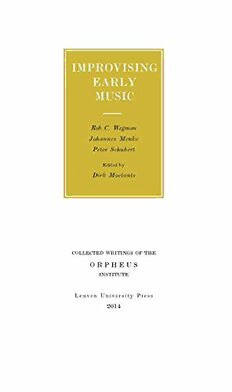
Improvising Early Music PDF
Preview Improvising Early Music
IMPROVISING EARLY MUSIC This eleventh publication in the series “Collected Writings of the Orpheus Institute” is edited by Dirk Moelants 2014 BOEK#6_def 31-01-2007 09:21 Pagina 3 IMTPORWOAVRISDISNG EATRONLYA LMIUTSYIC The HistoArysp oefc Mts uosfi Bcaalr Iomquperovisation from thMeu Lsiact Te hMeiodrdyle Ages to the Early Baroque Thomas Christensen Penelope Gouk Gérard Geay Rob C. Wegman Susan McClary JoMhaanrnkuess MJaennske PeJtoere lS Lchesutbeerrt Marc Vanscheeuwijck This eleventh publication in the series “Collected Writings of the Orpheus Institute” is edited by Dirk Moelants COLLECTED WRITINGS OF THE O R P H E U S INSTITUTE Leuven University Press 22000174 CONTENTS preface / p. 7 — Rob C. Wegman What is counterpoint? / p. 9 — Johannes Menke “Ex centro” improvisation - Sketches for a theory of sound progressions in the early baroque / p. 69 — Peter Schubert From improvisation to composition: three 16th century case studies / p. 93 personalia / p. 131 colophon / p. 135 5 PREFACE The study of improvised music is always a challenge, due to its volatility and unpredictability. But what about studying musical improvisation from before the age of sound recordings? In this book three experts give their view on aspects of musical improvi- sation in the late medieval, renaissance and early baroque periods. In his contribution, Rob Wegman surprisingly starts from the story of Beethoven’s lessons with Haydn to lead us all the way back to the 14th century and the origins of counterpoint. From there he takes up the history of improvised counterpoint, search- ing for traces of this practice in written sources. Seemingly a some- what frustrating search, as it seems impossible to get full access to the experience of improvised counterpoint, but in his search, the author finds clear traces of improvisation in written music. The main topic of the paper by Johannes Menke is musical prac- tice in the 16th and the 17th centuries, focussing not so much on the revolutionary changes that mark the transition to the Baroque period, but on those aspects of composition and improvisation that do not change radically. The central concept here is ‘ex centro’ sound structure: the practice of writing or improvising a soprano over a bass, rather than working around a central tenor. Although this practice is often considered as a feature of the Baroque, Menke traces this practice all the way back to the 15th century. The paper by Peter Schubert, finally, gives a more practical approach. Starting from an overview of improvisation tech- niques found in treatises from the Renaissance period, he gives examples, both from written compositions and from his own personal improvisation practice, to illustrate them and to make the link between improvisation and techniques used by compos- ers in the 16th century. As a whole, this volume shows us through historical sources how improvisation was an integral part of music education and 7 Preface how closely improvisation and composition were linked. This gives new insights in the way music was performed in its origi- nal historical context and a new way to look at written scores from the past. Dirk Moelants 8 What is Counterpoint? WHAT IS COUNTERPOINT? Rob C. Wegman 1. I would like to begin this contribution by taking the reader back to a year in the life of Ludwig van Beethoven. The year is 1792, and in that year, Beethoven was a young man in his early twen- ties. Although he was not well known outside his native city of Bonn, where he lived and worked, he had already been making a name for himself as an exceptionally talented musician and com- poser. Yet for a man of his promise a provincial town like Bonn was clearly too confining a place. It lacked the sorts of opportuni- ties he would need to realize his artistic gifts and aspirations. To everybody who knew the young Beethoven, it was obvious that he should go to the musical capital of the world—to Vienna, the city of Mozart and Haydn. It is true that Mozart had died the previous year. Yet the aging Haydn was still there, and was known to give private tuition to paying students. Few pupils could have seemed more deserving of study with Haydn than Beethoven. Earlier that year, Ludwig had briefly met the older composer, and had shown him some of his recent com- positions. To gain an impression of what he was able to show Haydn on that day, I would recommend listening to his Cantata on the Death of Emperor Joseph II of 1790 (WoO 87), an ambi- tious setting for soloists, orchestra, and choir, altogether lasting about 40 minutes, that richly testifies to the young man’s techni- cal assurance as well as to his ability to summon the dramatic power of the Viennese classical language.1 1. Among available recordings of this fine Cantata (of which unfortunately there are not many), I would recommend the one recorded in 1970 by the BBC Symphony Orchestra with BBC Chorus and Choral Society, dir. Sir Colin Davis, featuring Kiri Te Kanawa, soprano; Yvonne Newman, alto; David Barrett, tenor; and Michael Langdon, bass. 9
